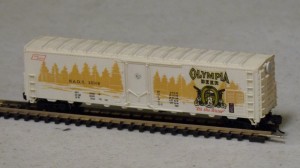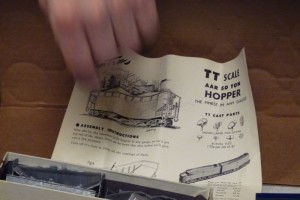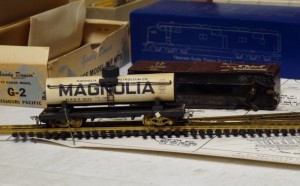Jeff Moorman
Please come join us on this Thursday, March 7, for our next clinic. Via the magic of video, we’ll be riding aboard Southern Pacific Cab Forward 4274 during its last run over Donner Pass on November 30, 1957.
Last month, our topic was using photography to improve your modeling. This wasn’t about photo backdrops, or creating building plans from photos, or using photo cutouts to mimic 3-D scenery. It was about the value of taking simple snapshots of your layout or individual models and studying them.
A photo stops time. When looking at a photo your brain is not distracted by what surrounds the scene, or is coming into view, or has just left the field of view. You have the opportunity to study the scene at your leisure.
During the clinic we slowly ran through about a dozen layout pictures Jeff took at the recent Pacific Science Center and Monroe Train Shows. So if you were an exhibitor at these shows, and your ears were burning the evening of February 7, it may have been because we were talking about your modeling.
Comments ran the gamut from very positive to “this looks like it could be improved.” We have some very fine modelers here in the Fourth Division. It is amazing how well their work stands up to the rigors of constant exhibiting – set up, tear down, store, set up, tear down, store, etcetera, etcetera, etcetera. So, not only is there some excellent craftsmanship, it is sturdy craftsmanship as well.
The only real criteria used for evaluating the modeling was whether or not it looked realistic, regardless of any special themes or the intended audience. Most of the items that caught the clinic attendee’s attention fell into one of three categories: (1) contrast of weathered versus shiny; (2) too sterile of an environment; and (3) unrealistic scenery.
There were several instances of a group of buildings where all but one or two were weathered. But those un-weathered structures stuck out like sore thumbs. Also we saw some examples of weathered sidewalls with very clean roofs. Nature seems to weather most buildings in the same locale uniformly. There were also cases of construction or mining scenes where some of the equipment was dirty and some pristine.
In one photo there was a little town at the edge of the layout. All the buildings were nicely modeled and uniformly weathered, the roads looked realistic, but there were no signs of habitation. There were no figures, no vehicles, no stray dogs, no trash barrels, or any other sign of life. The physical town was very well done, so it was a shame to see it just sitting there like an unused movie set. Similarly there were a couple of photos of industrial scenes with no trash, or clutter, or spare parts, or anything piled outside of the buildings. That doesn’t line up with what you see in the prototype world.
Most of the scenery issues were related to blending the ground into the backdrop. A 90 degree corner just doesn’t seem to cut it, particularly when the color hues do not match. Even background flats do not work well when you can see that 90 degree corner between the buildings, There was an example of a very nice forest scene, but as you approached you could see that all the trees were the same color and same shape, and were constructed in exactly the same way. And occasionally items in the photos just didn’t go together, like a beautifully modeled rocky hillside right next to a grove of plastic, toy trees.
Lastly, we found one of those classic model railroad situations where there was a bridge with no supporting pier.
The above makes it sound like there were all sorts of modeling issues. While there were certainly some opportunities for improvement, there was lots of nicely done work as well. So take a picture of your modeling and study the results. You might be surprised at what you find. And at what you might be able to improve.
Dennis T brought an N Scale Olympia Beer plug door refrigerator car to Show and Tell. It was pretty although no one was quite sure a prototype ever existed. BobJ brought some TT scale equipment he had just acquired. TT is 1:120 (one tenth inch to the foot) and had a fair following in the States before N scale became so popular. It still has practitioners, primarily in Europe.
To my eyes these TT cars looked just like HO scale models from the 50’s, albeit a little smaller. There was a coupler type I had never seen before, but other items were familiar. These included using a wrapper around the tank car, separately applied box car sides with printed detail, and zinc-like castings for the angle bracing and underframes of hoppers.
We meet at the Ronald United Methodist Church, 17839 Aurora Avenue North, Shoreline, WA, on the west side of Aurora (State Route 99) between 175th and 185th Streets and more specifically, between the Cadillac dealer on the south and Deseret Industries to the north. Going southbound on Aurora, make a right-hand turn into the church driveway immediately after passing the Deseret location. The parking lot is at the rear of the church. For regular meetings, enter the lower, left side of the church from the rear lot.
Meetings are the first Thursday of each month, except July and August. In June, we usually do a tour. Doors open around 7:00 PM and the program starts at 7:30.
Remember the next meeting is April 4 and the one after that is May 2. Hope to see you there or at least sometime on down the line.




No Comments Yet